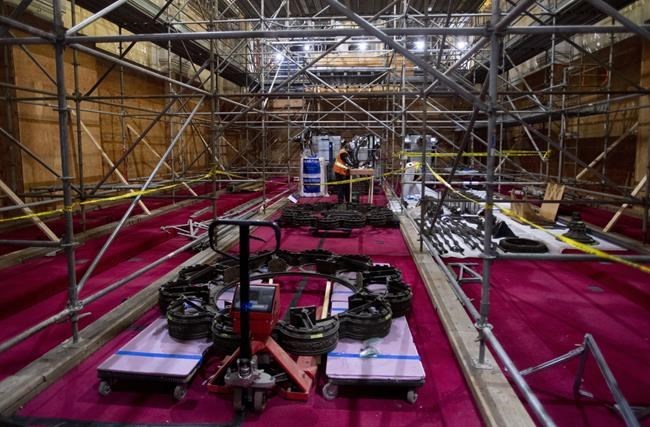OTTAWA — The scars from the 2014 attack on Parliament Hill are part of the "heritage fabric" of the iconic Centre Block and will not be fixed during extensive renovations on the building, according to a senior government official who provided a behind-the-scenes tour of the project.
That includes a series of bullet holes in the Hall of Honour from a gunfight involving Michael Zehaf-Bibeau, a sympathizer of the Islamic State militant group, on Oct. 22, 2014.
Zehaf-Bibeau, who stormed Parliament Hill minutes after fatally shooting Cpl. Nathan Cirillo in front of the National War Memorial, was killed in the shootout involving security and the RCMP in the stonewalled hallway connecting the building's front door and the Library of Parliament.
While parliamentarians were divided in the aftermath over whether to keep the bullet holes, Rob Wright, assistant deputy minister for Public Services and Procurement Canada and the official responsible for managing the renovations, says a decision was ultimately made to retain them.
"It's been decided that's part of the heritage fabric of this building now. So we plan on no changes to that," Wright said. "And those decisions would really be taken by Parliament."
The bullet holes aren't the only elements of Centre Block that workers are planning to keep intact as they work to retain the heritage and style of the building housing the House of Commons and Senate, while also updating it for the 21st century.
The upgrades will include adding modern heating, electrical and IT systems into the 100-year-old building. There will also be measures to make it carbon neutral, including plans to cover its three courtyards. Wright said Centre Block is the worst building for emissions in the parliamentary precinct.
There is no plan to change the physical size of the House of Commons, even though the chamber that sat 338 MPs before closings its doors for the time being will eventually need to accommodate 450 as Canada's population growth adds to the ranks.
Many other final design elements have yet to be nailed down. Until then, Wright is unable to say when the renovations will be finished — or how much they will cost.
Previous reports have suggested the renovations would take at least 10 years. Wright said the government has never committed to that time frame.
"We're getting more and more comfortable and confident that all of the decisions are coming together," he said. "And I think we should be in a good position in the first quarter of 2021 to really establish a baseline budget and schedule."
While the government is consulting with parliamentarians throughout the renovations as well as a panel of experts, Wright said public consultations on what the building should look like will be launched early next year.
The current Centre Block building is actually the second to be built on the spot, after the 1916 fire burned down the original, save the Library of Parliament.
The House of Commons has been temporarily moved to the recently refitted West Block, while the Senate is located in what used to be Ottawa's central train station.
On a behind-the-scenes visit to Centre Block Wednesday, excavators and a dump truck were seen working in a great 10-metre-deep pit that has been blasted in the ground in front of the Peace Tower. Workers in hard hats and safety all wore masks due to COVID-19 restrictions.
Inside the building, the granite walls have been covered by plywood or stripped off the reveal old red and black bricks held together by cracked mortar. Exposed pipes and wires run along the ceiling while the floor contains work tables and tools along with crates, some of which bear warnings about asbestos.
Workers have removed about 2,500 tonnes of asbestos from the building since demolition work started, Wright said. They have also carefully removed, recorded and packed numerous pieces of marble and granite from the walls.
In the House of Commons, the hand-painted linen ceiling has been taken down and put in storage, while the Senate's collection of First World War paintings are at the Canadian War Museum. The two chambers are filled with scaffolding leading up to their respective ceilings.
The final budget for the project has not been set, but Wright says about $120 million has been spent so far in stripping the building down. Wright says workers have found old newspaper articles as well as packs for gum and cigarettes in the walls.
There were more interesting discoveries outside. The eastern wing of Centre Block is built on an old military outpost known as Barrack Hill, and Wright says workers found military buttons and insignia. They also found the original walls of several outpost buildings and an old arrowhead.
"Those are all being carefully stored and identified and catalogued," he said, adding they are working with the Algonquin Nation on transferring the arrowhead to them.
Much of the work to date has taken place during the COVID-19 pandemic. Wright said it hasn't really had an impact even though site hosts about 400 workers each day, with companies from Ontario, Quebec, Manitoba, Alberta and British Columbia involved.
"I've been very impressed with how the construction industry has been able to adapt to this new challenge," he said.
This report by The Canadian Press was first published Dec. 2, 2020.
Lee Berthiaume, The Canadian Press



